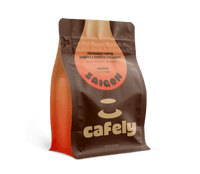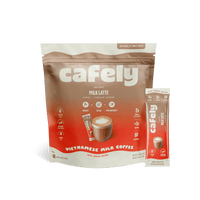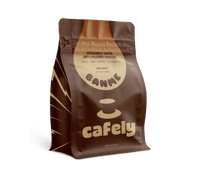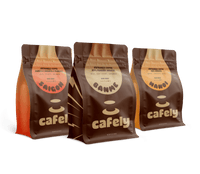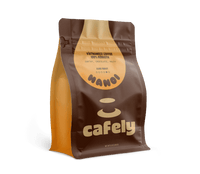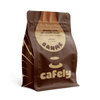Vietnam was a French colony from 1883 to 1954. As French colonizers settled along the Vietnamese coastline, they brought their love for cafe culture along with them.
This was a modest start to what eventually became a booming industry and vibrant culture in Vietnam.
It didn’t take long for French settlers to discover the fertile volcanic soil scattered across the Vietnamese countryside. This was the perfect place to set up new coffee plantations to fuel their insatiable appetite for coffee — or so they thought.
After several stop-starts, plenty of challenges, and setbacks, the Vietnamese took back their country from the French, reclaimed the coffee industry, and made it their own.
The Introduction of Coffee in Vietnam (1880s)

Vietnam’s coffee history is as rich as its coffee [1,2]. In the 1880s and 90s, French colonists started cultivating coffee on plantations, largely in the Ninh Bình and Quảng Bình provinces. The tropical climate and fertile soil were ideal for coffee production.
For a while, coffee production was slow, but in the 1920s, an economic growth phase encouraged colonists to relocate beyond already-populated areas. Colonization zones opened up in the highlands, mostly the Dak Lak Province, which remains a coffee hot spot today.
Labor Shortages (1930s)
With the growth of new plantations through the 1920s came the need for more labor, but the culture among the highland indigenous groups was vastly different than the lowlands.
Dependable labor became an issue, and shortly after World War I, the colonial administration started preventing lowland groups from migrating to the highlands and actively shipped soldiers off to fight in Europe. This caused further labor shortages, rising production costs, and unrest.
Coffee Leaf Rust Decimate Coffee Crops (1940–1954)
Hemileia vastatrix (coffee rust) is a disease affecting coffee plants around the world. It continues to pose a major threat to coffee plantations to this day.
This plant-eating fungus was first discovered in Vietnam in 1890 and became progressively worse up until its zenith in the mid-1950s when the coffee plantations were all but devastated.
Vietnam’s early Arabica coffee production production fell from 64.5% in 1945 to 1.7% in 1957. As devastating as this was, we can call it a blessing in disguise, as they realized one variety, Coffea canephora (syn: Coffea robusta), was resistant to the disease [3].
Despite this, the government discouraged coffee production, and many farmers moved back to the lowlands to focus on growing rice.
Related: Types of Vietnamese Coffee Beans
The End of French Colonial Rule (1954)
The French were defeated in 1954 and left Vietnam. The new government encouraged a return to the highlands for coffee production by offering tax exemptions, subsidies, fertile land, and a good income.
The massive migration would also help the government stay in control. There was minimal military control in the highlands, and the new settlements helped discourage uprisings from the minority groups there. Even after these government efforts officially ended, millions of people still moved there.
The Vietnam War (1955–1975)
The Vietnam War started in 1955 and continued until the eventual victory of North Vietnam in 1975.
Throughout this time, virtually all industries in Vietnam came to a halt — famine and poverty spread across the nation. Coffee farms were destroyed or abandoned, and exports from the country dried up.
After the war ended, the government decided to plant new crops in an effort to stimulate the economy. Robusta farms began popping up on old farmlands in the central highlands, and profits started to slowly build as Vietnam worked to rebuild itself.
Vietnam’s Golden Era (1980s & 90s)
It wasn’t until the late 1970s and early 80s before the coffee industry truly prospered in Vietnam. Reunification under a communist government brought more resettlement efforts through New Economic Zones (NEZ) and the Fixed Cultivation and Sedentarization Program (FCSP). What was the FCSP, you ask? Its goal was to motivate ethnic minorities to abandon nomadic behaviors. The state took over tribal lands, which were eligible for redistribution.
A new land law in 1993 allowed individuals to buy, mortgage, sell, inherit, and lease land (yet not actually own it since it still belonged to the state). Coupled with a coffee boom and rising prices for robusta in the 1990s, citizens rushed for a chunk of land so they could grow coffee. Between 1986 and 1996, coffee-producing areas grew at a steady 21% per year.
How Coffee Drives Vietnam’s Economy

Coffee’s impact on the economy is undeniable. Between 1995-1999, high coffee prices allowed people to buy bikes, water pumps, tractors, and other items that improved their quality of life.
When coffee prices declined in 2001, 45% of coffee-producing households lacked nourishment, and around half had to find other work, no longer able to live off of subsidies.
Now, Vietnam sits second in the world for coffee production. Thanks to good weather and higher yields, their 2023-2024 coffee production is predicted to be over 31 million bags GBE (green bag equivalent).
While we can say the country has contributed to coffee and coffee culture in many positive ways, coffee has impacted and even changed the country for both good and bad.
When Was the Traditional Vietnamese Iced Coffee Invented?
The first accounts of traditional Vietnamese iced coffee with condensed milk trace back to around the 1850s. Quickly after bringing coffee plants and cultivating them, the French colonizers and missionaries discovered that milk and dairy weren't widely used across Southeast Asia, and they'd have to import their milk from France.
With 6,073 nautical miles between the south of France and Ho Chi Minh City, fresh milk from France was never going to make it to Vietnam without souring. The French instead opted for condensed milk, which naturally has a much longer shelf life thanks to the sugar content and processing [4].
In order to enjoy a more traditional form of French coffee, or cafe au lait, the French missionaries and colonizers needed to find a way to add milk to balance out the bitterness from the strong coffee, making it more palatable for the masses.
Today, Vietnamese coffee is still brewed with a phin filter using high-quality robusta beans, such as our HaNoi coffee, and mixed with sweetened condensed milk. It can be served over ice or hot, though iced is most common.
How Has Vietnamese Coffee Changed Over the Years?
Vietnamese coffee has come a long way from one arabica coffee plant in 1857. In fact, by 1940, Vietnam exported an insane 2,000 tons of coffee per year [5]. That’s less than a century from introduction to widespread exportation.
Of course, this global spread of Vietnamese coffee came to a grinding halt during the Vietnam War as much of the Central Highlands where the plantations were had been destroyed. Following the war, private enterprise was back up and running after reforms in 1986, leaving the coffee industry free to flourish once more [6].
One of the biggest changes in Vietnamese coffee over the year was the switch from arabica to robusta as the bean of choice. It was first “discovered” in the French and Belgian colonies in central Africa, and botanist Edouard Luja showed it at the 1900 Paris Exposition.
Since then, it’s made up 97% of the coffee grown in Vietnam.
Related: What’s the Difference Between Robusta & Arabica Coffee?
FAQs: Vietnamese Coffee History

Okay, now that we’ve discussed the history of Vietnamese coffee, let’s check out these frequently asked questions.
1. What is the history of phin coffee?
Much like coffee culture itself, the phin filter was brought over by the French in the 1800s. This stainless steel brewing mechanism sits on top of a mug. Coffee grounds and hot water are added to the chamber, which then drips through a filter into the cup. It's still used to make traditional Vietnamese coffee. You can check out Cafely's Vietnamese coffee to be able to experience how authentic Vietnamese coffee should taste like.
2. Why is Vietnamese coffee made with condensed milk?
Vietnamese coffee is made of condensed milk since fresh milk wasn’t widely available in Vietnam in the 1800s. In order to enjoy their coffee without bitterness, the French colonists imported longer-lasting condensed milk from France.
Nowadays, that tradition has continued as many Vietnamese coffee stalls do not have refrigeration and fresh milk would turn sour very quickly in the humidity and heat of Southeast Asia. Cafely's instant Vietnamese coffee is a good choice for those who want their coffee in seconds.
3. What's special about Vietnamese coffee?
Vietnamese Coffee is special because of its stronger robusta beans and the addition of sweetened condensed milk instead of fresh milk. Though not traditional, it can be made with premium arabica beans, such as our DaLat coffee, for a lighter cup.
This combination creates a strong and sweet concoction that’s popular with people of all ages. It’s also more commonly enjoyed over ice, so you end up with a really refreshing coffee drink that hits the spot every time.
4. How much coffee does Vietnam grow?
Vietnam’s Central Highland region is a huge coffee producer, mainly growing robusta beans. In fact, it’s the second-largest coffee exporter in the world, with just over 20% of the market share after Brazil, which has 30.3%.
References
- Doutriaux, S., Geisler, C., & Shively, G. (2008). Competing for coffee space: development‐induced displacement in the Central Highlands of Vietnam. Rural Sociology, 73(4), 528-554.
- Rydstrom, H. (2015). Politics of colonial violence: Gendered atrocities in French-occupied Vietnam. European Journal of Women’s Studies, 22(2), 191-207.
- D’haezea, J. Deckersa; et al. (2005). Environmental and socio-economic impacts of institutional reforms on the agricultural sector of Vietnam Land suitability assessment for Robusta coffee in the Dak Gan region. Agriculture, Ecosystems, and Environment. 105 (1–2): 59–76. doi:10.1016/j.agee.2004.05.009
- Trinh, Phap Q.; de la Peña, Eduardo; Nguyen, Chau N.; Nguyen, Hoa X.; Moens, Maurice (2009). Plant-parasitic nematodes associated with coffee in Vietnam. Russian Journal of Nematology. 17 (1): 73–82.
- Fang, R., He, J., Lin, C., Xia, T., Xu, S., Chen, Q., & Xiao, G. (2023). Characterization and shelf stability of sweetened condensed milk formulated with different sucrose substitutes during storage. Food Chemistry, 404, 134402.
- Goscha, Christopher E. (2016). Vietnam: a new history. New York: Basic Books. pp. 157–158. ISBN 978-0-465-09436-3.
